

Unlike at approach or center positions, where under most conditions, the separation requirement is a set number of miles/feet for all aircraft; on tower, the separation requirements will vary greatly depending on aircraft performance and weight, departure courses, and relevant position of runways. In fact, local control involves the greatest number of variables when it comes to separation than any other ATC position. This topic will discuss the characteristics of each case of departure separation and its application.
1. Line Up and Wait (LUAW)
a. The intent of LUAW is to position aircraft on the runway for an imminent departure. Authorize an aircraft to line up and wait, except as restricted in subpara g of this topic, when takeoff clearance cannot be issued because of traffic. For example, this may happen when you have a tight string of departures at the same runway, and need to establish in-trail spacing for the succeeding aircraft; or have another aircraft landing or departing on the crossing runway. The common error new controllers make is positioning a departing aircraft on the runway *before* there’s a reasonable anticipation of an imminent departure (e.g., expecting an IFR release from departure control, which in fact may take several minutes.) This, essentially, may “clog up” the runway for extended period of time. If there’s an arrival that you hadn’t noticed before, you may find yourself in a position when you have to ask the holding aircraft to taxi off the runway in order to free it up for the landing traffic. This, of course, adds unnecessary complications. Only apply LUAW when you’re confident you’ll be able to issue takeoff clearance to the aircraft within moments.
Issue traffic information to any aircraft so authorized. Traffic information may be omitted when the traffic is another aircraft which has landed on or is taking off the same runway and is clearly visible to the holding aircraft. Do not use conditional phrases such as “behind landing traffic” or “after the departing aircraft.”
b. First state the runway number followed by the line up and wait clearance.
PHRASEOLOGY-
RUNWAY (number), LINE UP AND WAIT.
c. Do not issue a clearance to an aircraft requesting a full-stop, touch-and-go, stop-and-go, option, or unrestricted low approach on the same runway with an aircraft that is holding in position, taxiing into position or has been cleared to line up and wait until the aircraft in position starts takeoff roll. Do not clear an aircraft to LUAW if an aircraft has been cleared to land, touch-and-go, stop-and-go, option or unrestricted low approach on the same runway.
PHRASEOLOGY-
RUNWAY (number), CONTINUE, TRAFFIC HOLDING IN POSITION,
EXAMPLE-
“American 528, runway two three, continue, traffic holding in position.”
d. When an aircraft is authorized to line up and wait, inform it of the closest traffic requesting a full-stop, touch-and-go, stop-and-go, option or unrestricted low approach to the same runway.
PHRASEOLOGY-
RUNWAY (number), LINE UP AND WAIT, TRAFFIC IS A (type aircraft and position).
EXAMPLE-
“United Five, runway one eight, line up and wait, traffic a Boeing Seven Thirty Seven, six mile final.”
f. Do not authorize an aircraft to line up and wait at anytime when the departure point is not visible from the tower unless it is a departure only runway. On VATSIM, this is very subjective, and can only be practically applied in the VRC or vSTARS Virtual Tower View. When using the conventional radar client screen, it is always assumed the controller can see the intersection.
g. Between sunset and sunrise, LUAW can normally only be authorized at full-length of a runway (the very beginning of the runway), but not at a runway intersection. However, at vZLA it is acceptable to use LUAW at a runway intersection between sunset and sunrise as long as the runway is used for departures only, and only one aircraft is permitted to line up and wait on the same runway. The real-world procedures for intersection line ups between sunset and sunrise are slightly more complicated, but for the purposes of VATSIM controlling, the above two requirements are sufficient.
h. Do not authorize an aircraft to line up and wait at anytime when the intersection is not visible from the tower. On VATSIM, this is very subjective, and can only be practically applied in the VRC or vSTARS Virtual Tower View. When using the conventional radar client screen, it is always assumed the controller can see the intersection.
i. Do not authorize multiple aircraft to simultaneously line up and wait on the same runway between sunrise and sunset.
k. When aircraft are authorized to line up and wait on runways that intersect, traffic must be exchanged between that aircraft and the aircraft that is authorized to line up and wait, depart, or arrive to the intersecting runway(s).
EXAMPLE-
“United Five, Runway Four, line up and wait, traffic holding Runway Three-One.”
“Delta One, Runway Three-One, line up and wait, traffic holding Runway Four.”
Or when issuing traffic information to an arrival aircraft and an aircraft that is holding on runway(s) that intersect(s)
“Delta One, Runway Four, line up and wait, traffic landing Runway Three-One.”
“United Five, Runway Three-One, cleared to land. Traffic holding in position Runway Four.”
Or when issuing traffic information to a departing aircraft and an aircraft that is holding on runway(s) that intersect(s)
“Delta One, Runway Three-One, line up and wait, traffic departing Runway Four.”
“United Five, Runway Four, cleared for takeoff, traffic holding in position Runway Three-One.”
1. When a local controller delivers or amends an ATC clearance to an aircraft awaiting departure and that aircraft is holding short of a runway or is holding in position on a runway, an additional clearance shall be issued to prevent the possibility of the aircraft inadvertently taxiing onto the runway and/or beginning takeoff roll. In such cases, append one of the following ATC instructions as appropriate:
PHRASEOLOGY-
1. HOLD SHORT OF RUNWAY, or
2. HOLD IN POSITION.
n. When authorizing an aircraft to line up and wait at an intersection, state the runway intersection.
Phraseology-
RUNWAY (number), FULL-LENGTH, LINE UP AND WAIT.
EXAMPLE-
“American Four Eighty-Two, Runway Three-Zero full length, line up and wait.”
o. When two or more aircraft call the tower ready for departure, one or more at the full length of a runway and one or more at an intersection, state the location of the aircraft at the full length of the runway
when authorizing that aircraft to line up and wait.
PHRASEOLOGY-
RUNWAY (number), FULL-LENGTH, LINE UP AND WAIT.
EXAMPLE-
“American Four Eighty-Two, Runway Three-Zero full length, line up and wait.”
NOTE-
The controller need not state the location of the aircraft departing the full length of the runway if there are no aircraft
holding for departure at an intersection for that same runway.
{Reference: FAAO 7110.65 3-9-4 Line Up and Wait (LUAW).}
2. Anticipating Separation
Occasionally, there will be times when a prescribed separation does not yet exist for an aircraft awaiting takeoff clearance, but the controller can determine that it will exist by the time the aircraft starts takeoff roll. Under such conditions, anticipating separation comes in handy to avoid unneeded delays. The concept of anticipating separation is that a takeoff clearance needs not be withheld until prescribed separation exists if there is a reasonable assurance it will exist when the aircraft starts takeoff roll.
The anticipating separation is often most useful at airports with crossing runways. Let’s take Burbank airport as an example, where it is possible to have two aircraft depart from runway 15 and 8 with minimum delay between their takeoff clearances by anticipating separation. For the purposes of this example, we’ll assume that wake turbulence consideration is not involved (the preceding departure is not a heavy jet or B752.)
Envisage that you’ve cleared the runway 15 departure for takeoff, when you get a call from an aircraft approaching runway 8, ready for takeoff. A quick look at runway 15 tells you that the preceding departure is now rolling and is passing the Bravo-3 intersection. The prescribed separation is not to allow the succeeding departure start takeoff roll until the preceding aircraft is past the runway. However, considering that the runway 8 departure will need a few seconds to enter the runway and actually start rolling, it is obvious that by that time, the runway 15 departure will be well past the intersection of runway 8. Hence, you can issue the takeoff clearance to runway 8 departure right now, because you’re anticipating that the prescribed separation will exist by the time the runway 8 departures starts takeoff roll.
You can apply the same concept at any other airport with crossing runways for situations of departure and departure or departure and arrival separation.
{Reference: FAAO 7110.65 3-9-5 “Anticipating Separation.”}
3. Same Runway Separation
The same runway separation requirements discussed in this section refer to the minimum separation for runway operations, that is specifying the conditions when a runway may be considered available (or “clear.”) In addition to these requirements, controllers should consider the IFR and VFR separation minima (discussed later in this topic) before issuing takeoff clearances.
Same Runway Separation Categories
Aircraft same runway separation (SRS) categories are specified in the FAAO 7110.65 and based upon the following definitions:
Separate a departing aircraft from a preceding departing or arriving aircraft using the same runway by ensuring that it does not begin takeoff roll until:
a. The other aircraft has departed and crossed the runway end or turned to avert any conflict.
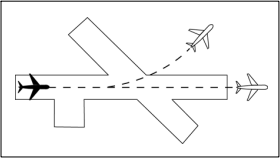
If you can determine distances by reference to suitable landmarks, the other aircraft needs only be airborne if the following minimum distance exists between aircraft:
1. When only Category I aircraft are involved - 3,000 feet.
2. When a Category I aircraft is preceded by a Category II aircraft - 3,000 feet.
3. When either the succeeding or both are Category II aircraft - 4,500 feet.
4. When either is a Category III aircraft - 6,000_feet.
5. When the succeeding aircraft is a helicopter, visual separation may be applied in lieu of using distance minima.
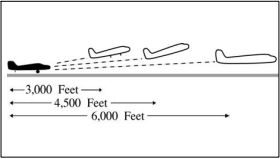
b. A preceding landing aircraft is clear of the runway.
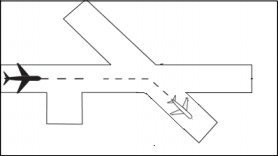
4. Wake Turbulence Separation for Same Runway
Wake turbulence is a phenomenon resulting from the passage of an aircraft through the atmosphere, similar to the wake you see on the water behind a moving boat. Every aircraft generates a wake while in flight. This disturbance is caused by a pair of counter-rotating vortices trailing from the wing tips. The vortices from larger aircraft pose problems to encountering aircraft. For instance, the wake of these aircraft can impose rolling moments exceeding the roll-control authority of the encountering aircraft. Further, turbulence generated within the vortices can damage aircraft components and equipment if encountered at close range. Hence, it is essential that controllers avoid positioning other aircraft directly behind an airborne heavy jet/B757. For this purpose, wake turbulence separation requirements have been developed to be used by ATC.
The term “wake turbulence” includes vortices, thrust stream turbulence, jet blast, jet wash, propeller wash, and rotor wash both on the ground and in the air.
a. Do not issue clearances which imply or indicate approval of rolling takeoffs by heavy jet aircraft. Rolling takeoff implies that the aircraft will not make a stop on the runway when transitioning from taxi to takeoff mode, it adds takeoff power just as it enters the runway prior to completely lining up on it. For many heavy jets, a rolling takeoff is a violation of the aircraft operating procedures, and should not be implied by ATC.
b. Do not issue clearances to a small aircraft to line up and wait on the same runway behind a departing heavy jet aircraft to apply the necessary intervals. The jet blast from a heavy aircraft is so strong, it can damage or even blow off a small aircraft off a runway if position directly behind. When following a heavy departure, small aircraft should be instructed to hold short of the runway until the prescribed separation exists.
c. Separate aircraft taking off from the same runway or a parallel runway separated by less than 2,500 feet by the following minima:

e. Separate a small behind a B757 aircraft by 2 minutes when departing:
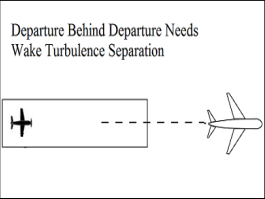
f. Separate aircraft departing from a parallel runway separated by 2,500 feet or more if projected flight paths will cross:
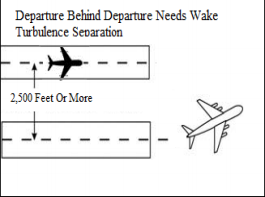
NOTE-
At airports with certified tower radar displays, the following radar minima may be used in lieu of the time intervals behind a heavy/super jet or B757.
1. Heavy behind super - 6 miles.
2. Large behind super - 7 miles.
3. Small behind super - 8 miles.
4. Heavy behind heavy - 4 miles.
5. Large or small behind heavy - 5 miles.
6. Small behind B757 - 4 miles.
g. When operating on a runway with a displaced landing threshold, departing aircraft may become airborne prior to reaching the point on the runway at which the landing aircraft has or is expected to touch/ed down, resulting in the arrival’s and departure’s flight paths crossing each other, subjecting the aircraft to wake turbulence separation. For this reason, controllers must separate aircraft whose projected flight paths will cross when an arrival follows a departure or a departure follows an arrival by the following minima:
Projected flight path - a line, course, or track along which an aircraft is intended to be flown.
Displaced threshold - a threshold that is located at a point on the runway other than the designated beginning of the runway. Displaced thresholds are depicted on NACO airport charts by three adjacent empty ovals crossing a point on the runway, with one oval inside, and two ovals outside the runway. For example, the KBFL runway 30R has a displaced threshold just south of the Echo intersection. Departing aircraft may use full-length of the runway, while arriving aircraft may only touch down inside the displaced threshold markers.
h. Air traffic controllers shall not approve pilot requests to deviate from the required wake turbulence time interval if the preceding aircraft is a heavy jet/B757.
i. Separate a small aircraft behind a large aircraft taking off or making a low/missed approach when utilizing opposite direction takeoffs on the same runway by 3 minutes unless a pilot has initiated a request to deviate from the 3-minute interval. In the latter case, issue a wake turbulence advisory before clearing the aircraft for takeoff.
NOTE-
1. A request for takeoff does not initiate a waiver request.
2. To initiate a waiver of the 3 minute rule, the request for takeoff must be accompanied by a request to deviate from the 3-minute rule.
j. Separate aircraft behind a heavy jet/B757 departing or making a low/missed approach when utilizing opposite direction takeoffs or landings on the same or parallel runways separated by less than 2,500 feet- 3 minutes.
k. Inform an aircraft when it is necessary to hold in order to provide the required 3-minute interval.
PHRASEOLOGY-
HOLD FOR WAKE TURBULENCE.
{Reference: FAAO 3-9-6 “Same Runway Separation.”}
5. Wake Turbulence Separation for Intersection Departures
a. Apply the following wake turbulence criteria for intersection departures:
1. Separate a small aircraft taking off from an intersection on the same runway (same or opposite direction takeoff) behind a preceding departing large aircraft (except B757) by ensuring that the small aircraft does not start takeoff roll until at least 3 minutes after the large aircraft has taken off.
NOTE-
Parallel runways separated by less than 2,500 feet with runway thresholds offset by less than 500 feet shall apply para 3-9-6, Same Runway Separation, subpara f.
2. Separate a small aircraft weighing 12,500 lbs. or less taking off from an intersection on the same runway (same or opposite direction takeoff) behind a preceding small aircraft weighing more than 12,500 lbs. by ensuring the following small aircraft does not start takeoff roll until at least 3 minutes after the preceding aircraft has taken off.
3. Separate a small aircraft taking off from an intersection (same or opposite direction takeoff) behind a preceding departing B757 aircraft by ensuring that the small aircraft does not start takeoff roll until at least 3 minutes after the B757 has taken off from:
4. Inform an aircraft when it is necessary to hold in order to provide the required time interval.
PHRASEOLOGY-
HOLD FOR WAKE TURBULENCE.
NOTE-
Aircraft conducting touch-and-go and stop-and-go operations are considered to be departing from an intersection.
b. The 3-minute interval is not required when:
1. A pilot has initiated a request to deviate from the intervals contained in subparagraphs a1 and a2.
NOTE-
A request for takeoff does not initiate a waiver request; the request for takeoff must be accomplished by a request to deviate from the 3-minute interval.
2. USA NOT APPLICABLE. The intersection is 500 feet or less from the departure point of the preceding aircraft and both aircraft are taking off in the same direction.
3. Successive touch-and-go or stop-and-go operations are conducted with any aircraft following an aircraft in the pattern that requires wake turbulence separation, or an aircraft departing the same runway that requires wake turbulence separation in accordance with subparas a1, a2, or a3, provided the pilot is maintaining visual separation/spacing behind the preceding aircraft. Issue a wake turbulence cautionary advisory and the position of the larger aircraft.
EXAMPLE-
“Caution wake turbulence, DC-9 on base leg.”
4. If action is initiated to reduce the separation between successive touch-and-go or stop-and-go operations, apply 3 minutes separation.
c. When applying the provision of subpara b:
1. Issue a wake turbulence advisory before clearing the aircraft for takeoff.
2. Do not clear the intersection departure for an immediate takeoff.
3. Issue a clearance to permit the trailing aircraft to deviate from course enough to avoid the flight path
of the preceding large departure when applying subpara b1 or b2.
4. Separation requirements in accordance with para 3-9-6, Same Runway Separation, must also apply.
{Reference: FAAO 7110.65 3-9-7 “Wake Turbulence Separation for Intersection Departures.”}
6. Intersecting Runway Separation
a. Issue traffic information to each aircraft operating on intersecting runways.
b. Separate departing aircraft from an aircraft using an intersecting runway, or nonintersecting runways when the flight paths intersect, by ensuring that the departure does not begin takeoff roll until one of the following exists:
1. The preceding aircraft has departed and passed the intersection, has crossed the departure runway, or is turning to avert any conflict.
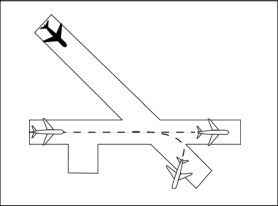
2. A preceding arriving aircraft is clear of the landing runway, completed the landing roll and will hold short of the intersection, passed the intersection, or has crossed over the departure runway.
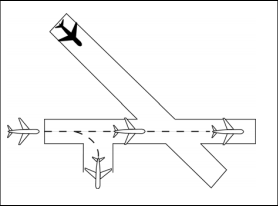
3. Separate aircraft taking off behind a departing or landing aircraft on an intersecting runway if flight paths will cross:
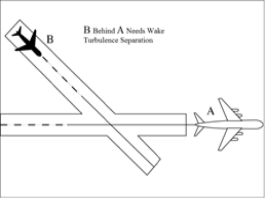
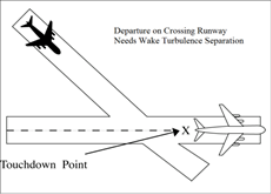
5. Pilot requests to deviate from the required time intervals must not be approved if the preceding aircraft requires wake turbulence separation.
{Reference: FAAO 3-9-8 “Intersecting Runway Separation.”}